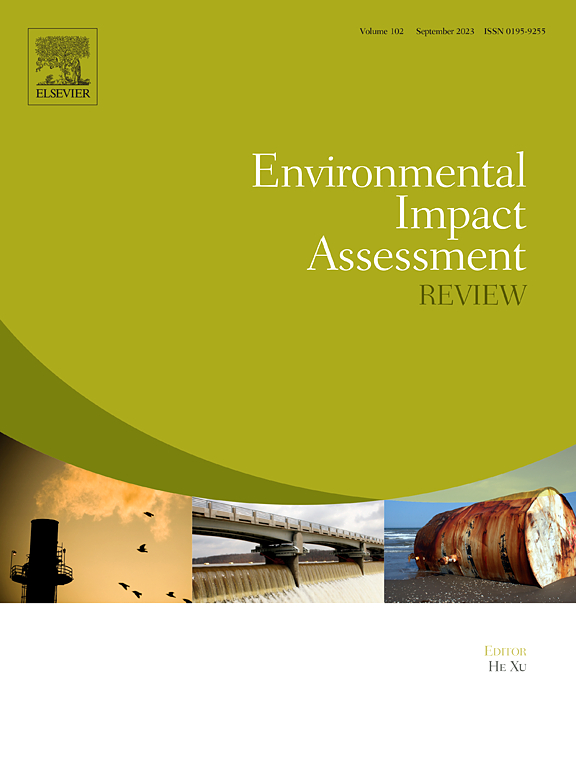使环境影响评估更加以人为本:在尼泊尔展示价值结晶方法,以获取当地的共同价值,供范围界定使用
IF 9.8
1区 社会学
Q1 ENVIRONMENTAL STUDIES
引用次数: 0
摘要
环境影响评估(EIA)是项目实施前规划和决策过程中的一个重要组成部分,因为它被用来预测和通报对当地社区(包括其社会、物理和自然环境)潜在影响的缓解情况。目前的环境影响评估程序主要关注那些可以用客观方法直接衡量的问题,而对于识别和记录与社区共同价值观有关的问题所需的一整套定性方法,大多只是象征性地使用不足。另一方面,众所周知,由于这些基于人类价值观的问题没有得到解决,很容易引发抗议和紧张局势。在这项务实的研究中,我们展示了一种方法,它可以通过明确界定的方式在短时间内捕捉当地社区的共同价值观,从而弥补这一差距。这种方法被称为 WeValue InSitu,它使当地社区能够在一个专门的结晶过程中构建他们自己定制的群体共同价值观声明,其输出结果是明确的原指标。在本研究中,我们将尼泊尔现有的两份环境影响评估范围界定报告的成果与我们在尼泊尔一个村庄中与十个小组合作开展的价值结晶方法的成果进行了比较,结果表明,后者能产生更多、更本地化的社区共同价值,并能揭示价值之间的潜在相互关系,为规划有效的缓解措施提供概念图。未来的研究可以探讨这种方法在改进环境影响评估和社会影响评估范围界定方面是否比现有的定性方法更具优势,以及/或机构和支持者的客观主义霸权是否是无法克服的障碍。本文章由计算机程序翻译,如有差异,请以英文原文为准。
Towards making EIA more human-centric: Demonstration in Nepal of a values crystallization approach to capture local shared values for scoping use
Environmental Impact Assessments (EIA) are a critical component of planning and decision-making processes before projects are conducted, because they are used to forecast and inform mitigation of potential impacts on the local community, including its social, physical, and natural environments. Current EIA processes predominantly focus on issues that can be directly measured using objective methods, with mostly tokenistic inadequate use of suites of qualitative methodologies needed for identification and documentation of issues relating to community shared values. On the other hand, protests and tensions are known to easily arise which are related to such human values-based issues not being addressed. In this pragmatic study, a method is demonstrated which can bridge this gap, by capturing local community shared values in a well-defined manner and short time. The approach, called WeValue InSitu, enables local communities to construct their own bespoke group shared values statements in a specialized crystallization process, with outputs which are well-articulated proto-indicators. In this study we compare the outputs from two existing scoping reports of EIA in Nepal with the outputs from the values crystallization approach which we conducted with ten groups in a village in Nepal, and show that the latter brings out many more, and more localised, shared values of the community, and additionally reveals underlying interrelationships between values, producing conceptual maps for planning effective mitigations. Future studies can investigate whether the achievements of this method offer any advantages to existing qualitative methods in improving EIA-SIA scoping, and/or whether the hegemony of objectivism of institutions and proponents is an unsurmountable barrier.
求助全文
通过发布文献求助,成功后即可免费获取论文全文。
去求助
来源期刊

Environmental Impact Assessment Review
ENVIRONMENTAL STUDIES-
CiteScore
12.60
自引率
10.10%
发文量
200
审稿时长
33 days
期刊介绍:
Environmental Impact Assessment Review is an interdisciplinary journal that serves a global audience of practitioners, policymakers, and academics involved in assessing the environmental impact of policies, projects, processes, and products. The journal focuses on innovative theory and practice in environmental impact assessment (EIA). Papers are expected to present innovative ideas, be topical, and coherent. The journal emphasizes concepts, methods, techniques, approaches, and systems related to EIA theory and practice.
 求助内容:
求助内容: 应助结果提醒方式:
应助结果提醒方式:


